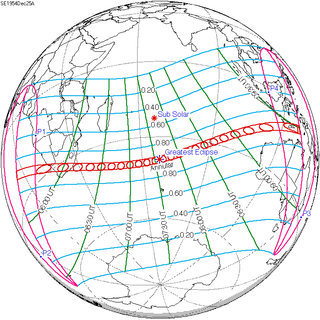| Solar eclipse of December 25, 1954 | |
|---|---|
| Type of eclipse | |
| Nature | Annular |
| Gamma | −0.2576 |
| Magnitude | 0.9323 |
| Maximum eclipse | |
| Duration | 459 s (7 min 39 s) |
| Coordinates | 38°24′S 68°12′E / 38.4°S 68.2°E |
| Max. width of band | 262 km (163 mi) |
| Times (UTC) | |
| Greatest eclipse | 7:36:42 |
| References | |
| Saros | 131 (47 of 70) |
| Catalog # (SE5000) | 9409 |
An annular solar eclipse occurred at the Moon's ascending node of orbit on Saturday, December 25, 1954 (also known as "The Christmas 1954 solar eclipse"),[1] with a magnitude of 0.9323. A solar eclipse occurs when the Moon passes between Earth and the Sun, thereby totally or partly obscuring the image of the Sun for a viewer on Earth. An annular solar eclipse occurs when the Moon's apparent diameter is smaller than the Sun's, blocking most of the Sun's light and causing the Sun to look like an annulus (ring). An annular eclipse appears as a partial eclipse over a region of the Earth thousands of kilometers wide. Occurring about 4.9 days after apogee (on December 21, 1954, at 8:50 UTC), the Moon's apparent diameter was smaller.[2]
Annularity was visible from the southwestern tip of South West Africa (Now Namibia), Union of South Africa (Now South Africa), Ashmore and Cartier Islands except Cartier Island, Indonesia and Portuguese Timor (Now East Timor). A partial eclipse was visible for parts of Southern Africa, Antarctica, Southeast Asia, and Australia.
- ^ "December 25, 1954 Annular Solar Eclipse". timeanddate. Retrieved 5 August 2024.
- ^ "Moon Distances for London, United Kingdom, England". timeanddate. Retrieved 5 August 2024.
